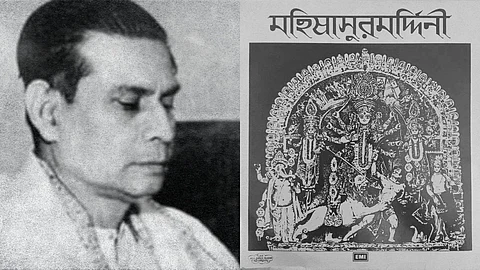
- HOMEGROWN WORLD
- #HGCREATORS
- #HGEXPLORE
- #HGVOICES
- #HGSHOP
- CAREERS
- ABOUT US
- CONTACT US

It’s morning and it’s a cold, dew-laden day in late September or early October. You’re still a child. You’re visiting your mother’s ancestral home. Your grandmother wakes you up with a cup of warm milk. The grown-ups are already on their second cup of milk tea with marie biscuits. Outside, the air hasn’t warmed yet; the sun hasn’t risen yet; but the sky is changing colour. Inside, the entire family has gathered in the living room. The grown-ups are sitting on the chairs, some on the floor, and you’re huddled together with your cousins on the big sofa. Someone — your grandfather perhaps — turns on the radio and rotates the knob until it reaches the right wavelength: All India Radio. It’s time. The old audio-record crackles to life with a long-drawn-out blow of the sacred conch shell, followed by the soothing, intoxicating Raga Malkosh — the mood of the early morning in Indian classical music. And then, Birendra Krishna Bhadra’s booming voice fills the room with his dramatic reading of the mythological story of the goddess.
You might think waking up at 4 a.m. to listen to a dramatic reading of the Durga mythology is a religious event, but no, it is entirely social. Some ninety years ago, Bengalis collectively decided that listening to Mahishasuramardini at 4 a.m. on the morning of Mahalaya — the first day of Devi Paksha, the fortnight of the goddess when Durga Pujo is held — is going to be a part of our Pujo culture from now, and we have been listening to it since. Like Christmas carols in the UK, the Mahishasuramardini songs and recitals are an essential part of Bengali culture.
The 1930s was a time of great social, cultural, and political change. The inter-war lull in European great power politics was coming to an end, and with the second World War looming at the horizon, the colonial powers’ grip on their distant colonies was loosening. It was a time of great nationalist fervour. In India, this nationalist spirit found expression in a renaissance of the Indian classical arts, music, and mythologies, and led to a popular desire to preserve and celebrate the essence of India’s ancient cultural heritage.
Amidst this cultural revival of the 1930s, the idea of Mahalaya as a collective celebration began to take shape. Mahalaya — meaning ‘The Great Moment’ — marks the end of Pitri Paksha and the beginning of the Devi Pakasha. Historically, Mahalaya was the ritual ceremony of offering homage to one's deceased ancestors and the Chakkhudaan (“eye-offering”) ceremony when the eyes are painted on the Durga idol, giving the goddess ritual life. In the 1930s however, this private ritual was transformed into an occasion for collective celebration.
Birendra Krishna Bhadra — a singer, playwright, and voice-actor — was one of the pioneers of Indian radio, and played an important role in this transformation. His embrace of the relatively modern radio media combined with his training in Indian classical music and command of the Sanskrit language made him something of a maverick. Together with poet-writer Baidyonath Bhattacharya (better known as ‘Bani Kumar’), and composer Pankaj Mullick, Bhadra created the script for ‘Mahishasuramardini’ (The Demon-Slayer), drawing from various sources like ancient hymns, religious scriptures, and contemporary devotional songs. A composite radio play that brought together an ensemble cast of popular singers and musicians of the time, the programme was an unprecedented celebration of Indian mythology and classical arts. First broadcast on Akashvani (then the India State Broadcast Services, later renamed All India Radio in 1936) at 4 a.m. on the morning of Mahalaya, September 22, 1931, the programme was an instant success and became an overnight cultural phenomenon.
Although initially broadcast as a live performance, the programme was first recorded in 1958, and has been broadcast in a pre-recorded format since 1966. During the Emergency era, All India Radio tried to revamp the programme by rebooting it as “Durga Durgatiharini” and replacing Bhadra with Uttam Kumar — Bengali cinema’s first superstar — and Pankaj Mullick with Hemanta Mukhopadhyay — himself a legendary music director, singer, and composer — in 1976. But the backlash was swift and vicious, and forced All India Radio to issue a public apology and bring the original programme back on air. The controversy cemented Bhadra’s legacy as a cultural icon and made the programme synonymous with celebrations of Mahalaya and Durga Pujo. The controversy was the basis of a 2019 film based on Birendra Krishna Bhadra's life titled 'Mahalaya'.
Almost a century later, Mahishasuramardini is just as popular as ever and marks the beginning of Bengal’s pujo season every year at 4 a.m. on the morning of Mahalaya.
If you enjoyed reading this, here's more from Homegrown:
Beyond Tradition: The Cultural Evolution Of Durga Puja In Modern-Era Kolkata
How Generations Of Kumartuli's Artisans Have Crafted A Culture Of Devotion For Durga Puja
Summoning Durga Through Photos Of Indian Widows: An Interview With Sharmistha Dutta
